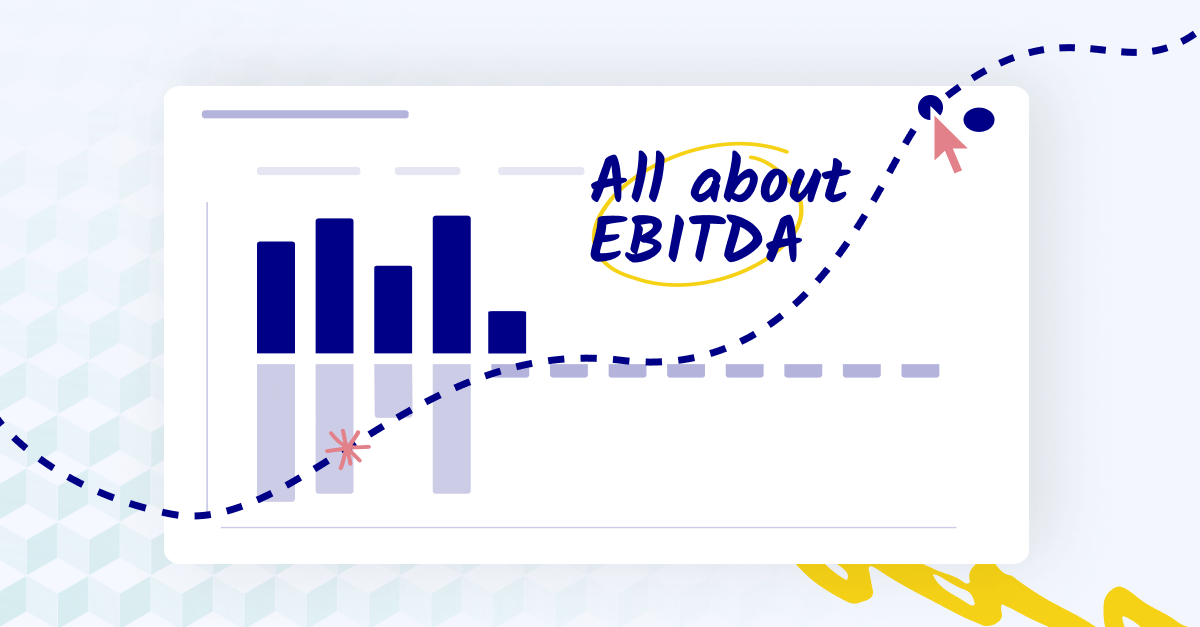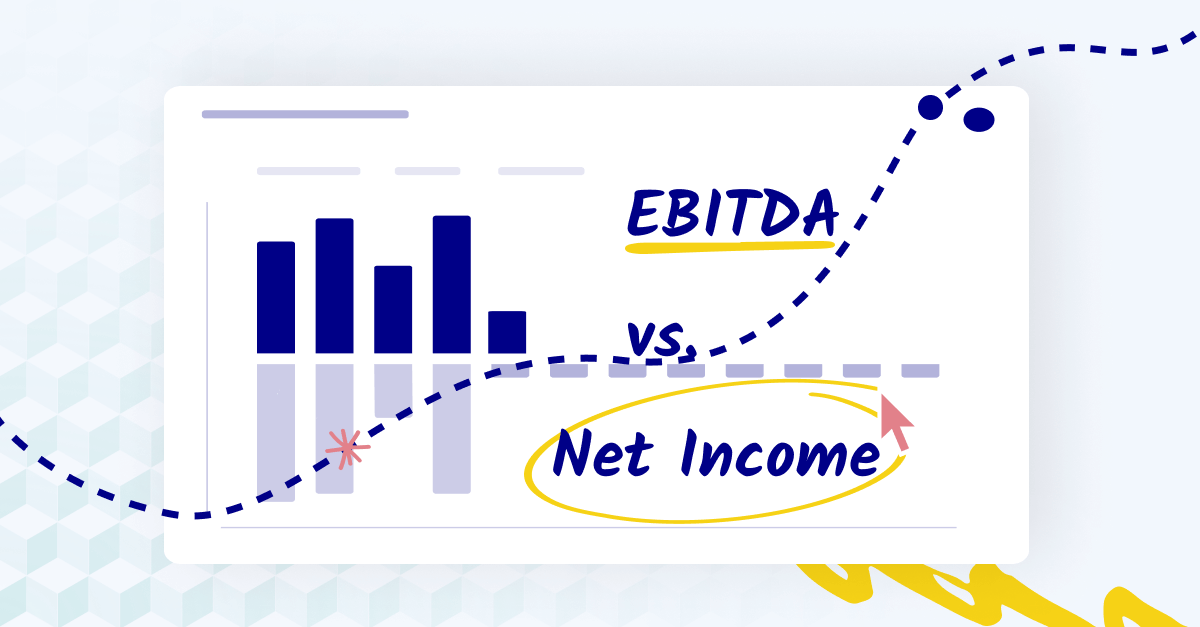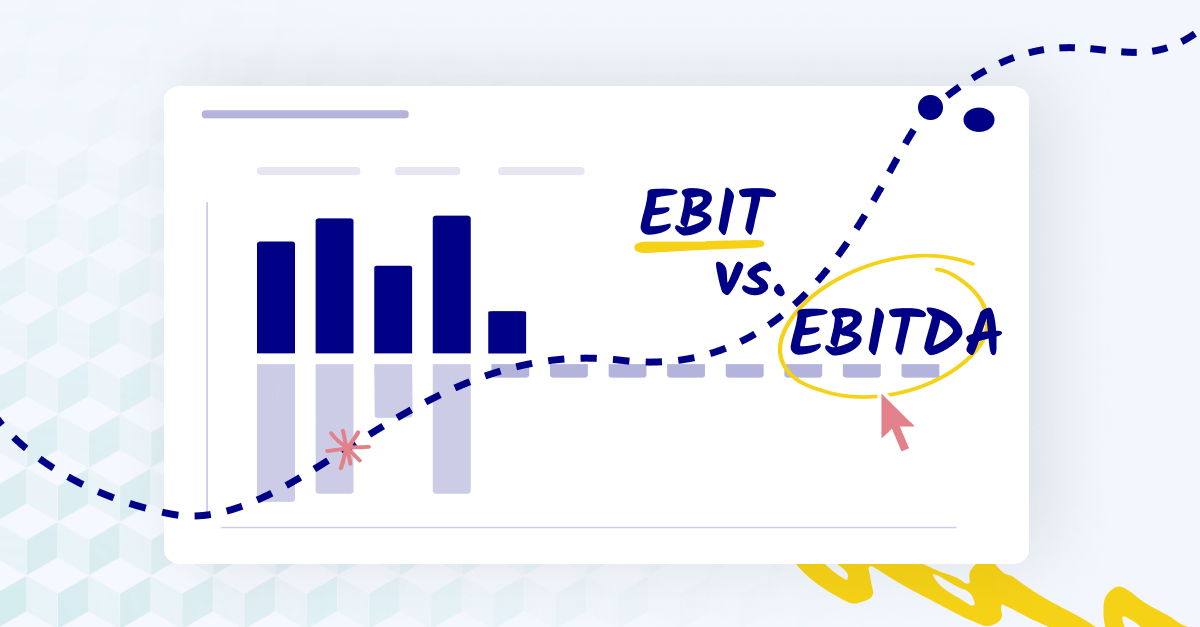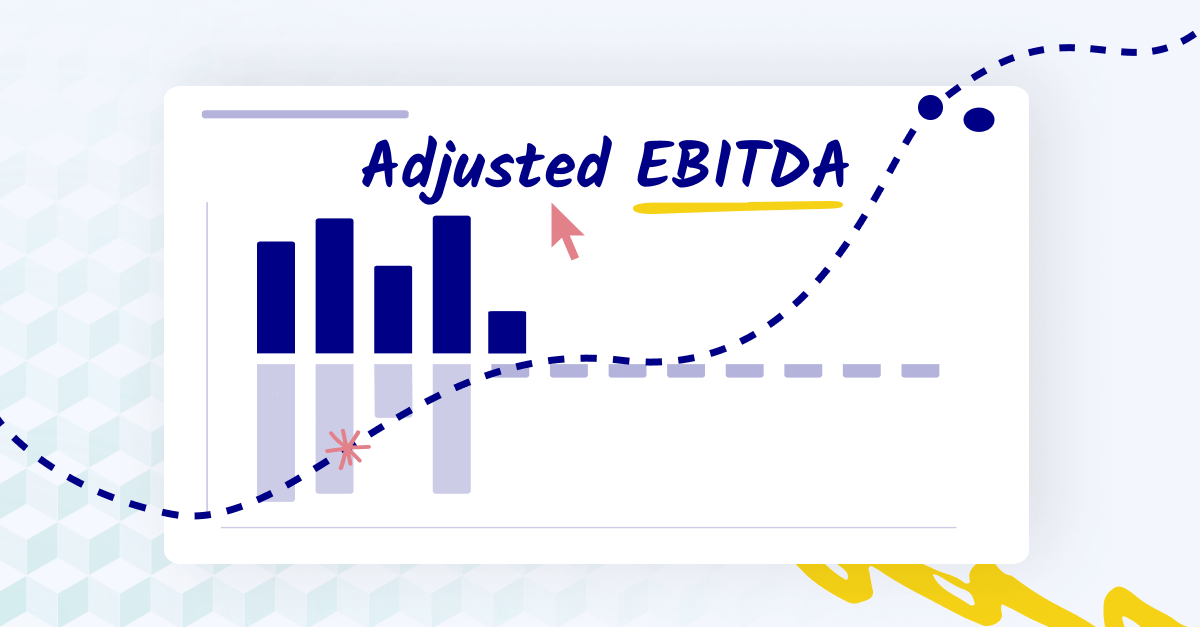What is EBITDA?
EBITDA is "Earnings Before Interest, Taxes, Depreciation, and Amortization."
.png?width=600&height=314&name=EBITDA%20definition%20(1).png)
It measures a company's operating profit that strips out interest expenses, taxes, depreciation, and one-time charges.
EBITDA is one of the critical indicators of a company's financial health. It's also one of the most common methods of determining a company's earning potential, like the Rule of 40 and the SaaS magic number.
EBITDA is a non-GAAP financial measure.
Let's break this into two parts:
- Earnings before interest + taxes
- Depreciation and amortization expense
EBITDA is different than EBIT (Earnings Before Interest and Taxes)
Earnings before taxes and interest (EBIT) is a calculation that shows how much money a company has earned after expenses have been paid but before any deductions for things like income taxes or interest payments.
EBIT helps CFOs understand a company's financial health and better decide where to allocate their resources. It can also be used as a benchmark to compare the profitability of different businesses in the same industry.
Here's the formula:
EBIT = Net income + interest + taxes
What's a depreciation and amortization expense?
A depreciation and amortization expense is an accounting term that refers to long-term assets' gradual loss in value.
In other words, any capital expense that loses value over the course of its lifetime—that loss in value is depreciation (for tangible assets) and amortization (for intangible assets).
As such, depreciation and amortization are non-cash expenses.
Businesses use this term to account for the wear and tear of their equipment and the reduction in the value of intangible assets such as copyrights and trademarks.

How to calculate EBITDA
There are two methods of calculating EBITDA.
The first way uses operating income as a starting point.
The second uses net income.
No matter which method you choose, the EBITDA calculation is super simple.
Method 1: Begin with operating income
If you know your operating income, add your known depreciation and amortization expenses to get EBITDA.
Here's the first EBITDA formula:
.png?width=600&height=338&name=EBITDA%20-%20Operating%20income%20plus%20D%26A%20expenses%20(1).png)
EBITDA = Operating Income + Depreciation & Amortization expenses
If you need a refresher: operating income is your company's profit after subtracting operating expenses (the costs of running the business)—it's the money your business makes from its operations.
The most common way to calculate operating income is to subtract operating expenses from sales.
Since you haven't yet subtracted interest or tax expenses, you only need to add depreciation and amortization expenses.
You can usually find depreciation and amortization expenses beneath "operating expenses" on the income statement.
This means depreciation and amortization are often counted under cash flows from operating activities on the firm's cash flow statement.
Method 2: Begin with net income
Here's the second EBITDA formula:
.png?width=600&height=338&name=EBITDA%20-%20net%20income%20plus%20taxes%20plus%20interest%20+%20D%26A%20(1).png)
EBITDA = Net income + taxes + interest expenses + depreciation & amortization expenses
To reconstruct the first formula, you can begin with net income, additional taxes, and interest expenses.
The net income, tax expense, and interest expense figures can be found on the income statement, so this method is easier to read off the income statement.
That said, net income includes line items that might not be included in operating income, like one-time expenses. So these two EBITDA calculations can yield slightly different results.
What is EBITDA margin?
The EBITDA margin measures a company's operating profit as a percentage of its revenue.
This tells you how much profit a company makes on each sales dollar.
-png.png?width=600&height=314&name=EBITDA%20margin%20definition%20(1)-png.png)
A high EBITDA margin means the company is doing an excellent job of turning its revenue into profits.
A low EBITDA margin means that the company is not doing as well.
Using EBITDA margin to compare the value of investments
The EBITDA margin can help you decide whether or not to invest in a company, and it’s also used by banks when they determine how much money to lend to a business.
EBITDA helps us make easier comparisons to other businesses by determining each business's profitability.
Comparing those numbers helps investors, CFOs, and FP&A teams understand the impact of a company's capital structure (e.g., debt and capital expenditures, as well as differences in taxes) on the company's actual profits and cash flows.
That can go a long way toward helping you decide if a company is worth investing in and what price it's worth.
Companies with higher EBITDA margins make more attractive investments.
Why is EBITDA important?
Because it's a good measure of a company's operating cash flow.
EBITDA allows investors to compare companies across different industries without worrying about other expenses that can vary significantly from company to company.
For example, companies in different industries may have very different tax rates. As a result, comparing their net incomes would not give an accurate picture of their profitability.
That said, comparing their EBITDA gives us a better idea of how well each company is doing.

Limitations of EBITDA
There are a few limitations to using EBITDA as a measure of profitability.
EBITDA doesn't include all expenses
For example, it doesn't account for the cost of goods sold (COGS). This is an essential expense for many companies, particularly those in the manufacturing or retail industries.
As such, EBITDA can overstate the true profitability of these types of businesses.
EBITDA doesn't account for changes in working capital
Working capital is the money that a business needs to finance its day-to-day operations. It includes things like inventory and accounts receivable.
A change in working capital can significantly impact a company's cash flow, but it will not be reflected in its EBITDA.
EBITDA, when viewed in isolation, can create misunderstandings
Using EBITA to create misleading conclusions about a company's profitability is possible.
For example, a business that invests heavily in capital assets or intellectual property may have a positive EBITDA without being profitable. That company's assets are increasing even if that company's net income doesn't change.
Comparing EBITDA can be like comparing apples and oranges
One company's EBITDA is challenging to compare to another company's EBITDA.
If you want to use EBITDA to compare a company's operating performance to another in the same industry, you should use adjusted EBITDA (also called normalized EBITDA).
What is adjusted EBITDA?
Adjusted EBITDA is essentially EBITDA plus or minus one-time adjustments.
This method of standardizing EBITDA by removing anomalies makes the resulting adjusted (or normalized) EBITDA easier to compare to that of other companies in the same industry.
.png?width=600&height=314&name=Adjusted%20EBITDA%20definition%20(1).png)
Here's a list of some of the adjustments you might exclude:
- Non-operating revenue (such as asset appreciation)
- One-time gain or sale of property
- Impairment of goodwill
- Impairment of assets
- Forex gains/losses
- Unrealized gains and losses
- Legal expenses
- Restructuring and reorganization
How do I calculate adjusted EBITDA?
The adjusted EBITDA calculation is pretty straightforward:
Adjusted EBITDA = EBITDA +/- Adjustments
One caveat:
When calculating the adjusted EBITDA of different companies, make the same adjustments for every company.
Otherwise, you need to make a valid comparison.
EBITDA frequently asked questions
You might still have some questions about EBITDA.
What's the difference between EBIT vs. EBITDA?
EBIT and EBITDA are two different measures of a company's profitability. EBIT is earnings before interest and taxes, while EBITDA is earnings before interest, taxes, and depreciation.
So the difference between EBIT vs EBITDA is that EBIT is net income excluding interest and taxes, while EBITDA excludes depreciation and amortization.
-png.png?width=600&height=314&name=EBIT%20definition%20(1)-png.png)
EBIT is more commonly used because it's simpler to calculate. Still, EBITDA is a more accurate measure of a company's performance because it takes into account the effects of depreciation.
Both measures are essential, but they should be used differently. For example:
- EBIT is often used as a measure of operating profit.
- Companies in asset-intensive industries (such as utilities or infrastructure) usually prefer EBITDA over EBIT.
- EBIT and EBITDA are not GAAP metrics
- Some investors are mistrustful of EBITDA as a performance metric because it can paint a misleading picture of a company’s financial health.
Understanding the difference between them is important to make informed decisions about investing in a company.
What's the difference between EBITDA vs. net income?
EBITDA is earnings before interest, taxes, depreciation, and amortization expenses. Net income is sales minus the cost of goods sold, general expenses, taxes, and interest.
In other words, EBITDA is net income before taxes and interest.
Since EBITDA excludes the advantages or disadvantages of a company's capital structure and tax situation, it's a more accurate measure of that company's earning power than net income.
Read more on the difference between EBITDA vs. net income here.
What's the difference between EBITDA vs. revenue?
Revenue is the gross amount of cash a business makes from operating activities.
EBITDA focuses only on operational profitability, ignoring non-cash expenses by adding them back to net income.
Revenue measures sales activity but EBITDA measures profitability.
What are interest expenses? Are they included in EBITDA?
Interest expenses are the costs incurred from borrowing funds. It's a non-operating expense shown on the income statement.
You can subtract interest expenses to calculate EBITDA.
What's the difference between EBITDA vs. cash flow?
Some people use EBITDA and cash flow synonymously, but there's enough difference between them that we don't recommend this practice.
"Cash flow" is often shorthand for "operating cash flow."
But operating cash flow tracks the cash generated by a business's operations, ignoring cash flow from investing or financing activities. It includes interest and taxes.
On the other hand, EBITDA doesn't include interest and taxes.
So while both measure how well a company performs, there's a difference between interest and taxes.
Why doesn't Warren Buffett like EBITDA?
The famed investor dislikes EBITDA because it excludes capital expenditures.
In fact, he's credited with the line in a letter to Berkshire Hathaway shareholders: “Does management think the tooth fairy pays for capital expenditures?”
.png?width=600&height=314&name=Warren%20Buffett%20on%20EBITDA%20(1).png)
Because EBITDA excludes CapEx and changes in net working capital, Buffett doesn't think it's a true measure of a company's profitability.
That said, despite Buffett's criticism, EBITDA is still one of the most widely used financial metrics to report on a company's financial operations.
...and what should you use instead?
Free cash flow gives a better idea of a company's profitability after it has covered its cash expenses, which include interest and taxes.
Conclusion: EBITDA is a measure of a company's financial performance
EBITDA is an important metric for measuring a company's profitability and cash flow.
However, there are some limitations you should consider.
- EBITDA doesn't include all expenses
- EBITDA doesn't consider changes in working capital
Despite these limitations, EBITDA can still give you valuable insights into your business's performance.
And if you're interested in keeping a closer eye on your company's EBITDA (and other important financial metrics), you should consider Cube.
It's a spreadsheet-native FP&A platform that connects with your GL and other source systems, enforces data integrity, and makes investor reporting simple and easy.
If that sounds intriguing to you, click the banner below to request a free demo.



.png)





.png?width=600&height=314&name=EBITDA%20definition%20(1).png)

.png?width=600&height=338&name=EBITDA%20-%20Operating%20income%20plus%20D%26A%20expenses%20(1).png)
.png?width=600&height=338&name=EBITDA%20-%20net%20income%20plus%20taxes%20plus%20interest%20+%20D%26A%20(1).png)
-png.png?width=600&height=314&name=EBITDA%20margin%20definition%20(1)-png.png)
.png?width=600&height=314&name=Adjusted%20EBITDA%20definition%20(1).png)
-png.png?width=600&height=314&name=EBIT%20definition%20(1)-png.png)
.png?width=600&height=314&name=Warren%20Buffett%20on%20EBITDA%20(1).png)



